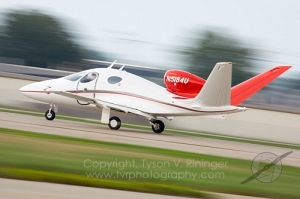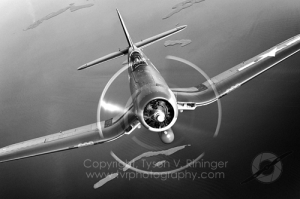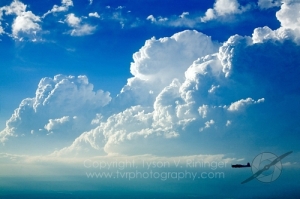
If you’ve already checked my first tutorial on tips and tricks of photographing an air show, this section will introduce you to the aspects often overlooked. To most, an air show is an event that takes place in front of a crowd, but if you look carefully you’ll find that an air show, or any event for that matter, provides photographic opportunities all around.
A fun challenge to noticing these opportunities is to ditch every lens but one. Force yourself to shoot with a single 50mm lens and see what happens. Eventually you’ll find yourself becoming more selective with the finer details on an aircraft, including atmospheric conditions that were once outside your field of view, or capturing the expressions of joy on people’s faces since the aircraft flying are no longer an option.
The first section concentrated mainly on the overall aspect of air show photography like prop blur, lighting and positioning. In this section we’ll cover the more artistic and detailed side of air show photography like macro, individuality, journalism and documentation.
It’s all in the details

Limiting the selection of lenses will enable a photographer to notice things many others would simply pass over such as this ammo belt on the B-25 'Executive Sweet'.
Going back to sticking with one lens is undoubtedly the best way to exercise creativity. Although our minds know what it is we want to photograph, the limitations of a single perspective force us to find a way of conveying the story we want to tell within the confines of what the camera will allow.
Historically, (though not literally) a 50mm lens on a full-frame D-SLR is equivalent to what we see with the human eye in relation to the perceived distance to a subject. Of course our peripheral vision enables us to see a wider field of view than what a 50mm allows. This is where our eyes conflict with what the camera will let us do. It is our creativity and ability to artistically compose an image within those confines that makes someone an artist in the true sense of the word. Rather than forcing something to fit within a frame by zooming in or out, dealing with limited composition options will allow a photographer to become more creative with other aspects of photography like depth of field, spot metering and placement of the main subject. These finer details will lend to the overall mood of the image.
With that concept in mind, pick out a detail on an aircraft you find intriguing. It could be a leading edge slat, a pitot tube, even the corner of a fuselage window. Abstract photography is an art form all its own and can add a curious element to your air show photography collection.
Extreme Wide Angle
Now that digital photography has equaled the constraints, or versatility, of the film world by providing an economical 135mm full-frame sensor, extreme wide angle imagery can add an element of wonder.

Taking advantage of an extreme wide angle lens can present an otherwise ordinary subject in a way others haven't seen it before.
Both Nikon and Canon are increasing their share of wide angle lenses and pushing the boundaries of optical technology. This enables the photographer to create worlds the viewer has never seen before. If photography’s rule of thumb is to show an ordinary object as it has never been seen before, wide-angle photography can become quite an asset.
Some examples of potential wide-angle photography ideas would be to capture the enormous tail of a C-5 Galaxy in its entirety or the exhaust of an F-15 Eagle. Practical uses would be the interior of an aircraft where the confines couldn’t be captured any other way. Extreme examples would be concentrating on the lengthy nose of a jet or even capturing a child from below, looking skyward at a passing formation of aircraft.

Besides using a wide-angle lens purely for creativity, getting to know the limitations of such finicky optics can prove beneficial for more practical purposes.
Wide-angle photography is a pretty forgiving technique in that there is so much in the frame. Often times you can ‘shoot from the hip’, so to speak, by capturing images without the need to look through the viewfinder. Aiming the camera in an approximate direction and angle will yield fairly predictable results as compared with trying the same technique using more precise telephoto lenses.
There is however a downside to wide-angle photography. The extreme effect of these lenses is of a niche style. Be careful not to overdo it as too many extreme wide-angle or fisheye images contained within a portfolio could become monotonous and routine. The idea is to mix it up and only use these lenses during appropriate situations.
Nothing turning on something burning?

Just because a jet doesn't have a propellor, maintaining the practice of achieving some form of motion blur will only add to the impact of the image.
One of the key elements to aviation photography involving a propellor or rotary driven aircraft is no doubt some form of prop-blur. The technique of slowing down the shutter speed to give a sense of action is one of the most challenging vices an aviation photographer faces. If the shutter speed is too slow, the photo becomes blurry. If the shutter speed is too fast, propellors or helicopter blades look frozen resulting in no sense of motion.
With that being said, most photographers let out a sigh of relief when a jet takes to the skies. Since there are no visibly moving parts, there is no need for any form of blur. Or is there?
Capturing some sort of motion when photographing jet aircraft can be a challenge. To accomplish this, slow down your shutter speed when there are partly cloudy skies present or the aircraft is flying low enough for there to be some sort of background.
Since images of jets streaking across a solid blue sky are very common, a sense of motion is already perceived. Freezing the jet against a mountainous background isn’t going to kill the image or leave the viewer wanting more, however blurring the background or adding that element of motion will only add to the impact of the photograph.
Thinking outside the genre

Just like an automotive shoot, adding motion blur and tilting the camera can often give an image 'attitude'. This aircraft, the Eclipse Concept Jet (ECJ) was taxiing after a demostration.
Often times photographers will check out the work of other photographers in their field for new ideas or techniques. Improving on those techniques is what pushes photographers to achieve new and exciting imagery. But what if photographers expanded their research to cover aspects of other genres of photography.
Motor sports photography shares many similarities with that of aviation in regards to equipment and technique, but what styles could be adopted by either genre to put a spin on things?

Aviation photography will often require the photography to exercise other skills such as portraiture, fine art or product photography. Knowing how to pull off successful imagery in multiples genres is a valuable tool.
Ever notice how automotive photographers will ask that that the parking lights remain on during a shoot? How about the front wheels being turned hard right or left? Many automotive photographers tilt the camera to provide a sense of action even though the vehicle is parked. These are just some of the ways automotive photography techniques could be transferred successfully to aviation.
Of course it doesn’t end there. Aircraft are pointless without their operators, so why not check out cutting-edge portrait photography. The individual components of an aircraft all working together are crucial for the aircraft’s success. To better concentrate on those components, check out commercial or studio photography techniques. Even other fine art photographers can provide suggestive tips like white space, symmetrical and asymmetrical examples as well as abstract imagery.
All too often we limit ourselves according to what the status quo may be at that given time. As IBM initially coined, artists need to continually “think outside the box”…or viewfinder. Take your pick.
Black & White will never die

Black and White imagery will always be timeless. If done right, it can produce vintage images once only imagined during that time period.
Sure, film is just about dead. There are a few of us still trying to keep it alive by using infra-red, medium and large format C-41 and transparency films, and others. But all and all it’s safe to say, sadly, film is dead. Fortunately black and white lives on and probably always will.
Although some cameras will allow black and white photography through various custom functions, my advice would be to ignore these features. After all, why would you limit yourself. If you shoot in black and white, that is all you will get, black and white. If you shoot in color, you will not only get a useful color image, but with the proper techniques, a beautiful black and white image to add to your gallery.
When done correctly, a black and white photograph can bring back the nostalgia of the day when warbirds or period correct aircraft are illustrated. With the advancements in technology and improved photographic techniques, photographers can bring the past to life in ways we could only imagine back then.
For the best black and white practices, brush up on old school black and white printing techniques such as dodging and burning, maintaining shadow detail and perhaps even understanding how the Zone System works. In regards to best Photoshop black and white conversion techniques, a quick browse on your favorite search engine should do the trick. But the one tip I’ll suggest is to not use the ‘desaturate’ tool or the straight-forward black and white conversion tool. Use of these tools will result in muddy and low-contrast gray images. Take your time and do it right.
Place the plane game

Following the 'Rule of Thirds' is good practice for any photographer, but knowing when to break that rule can provide equally successful imagery. In this case, since both the sky and the foreground were uneventful, creating symmetry with the aircraft's reflection warranted placing the horizon in the middle of the frame.
Finally, there’s composition. Normally this would be a biggie on the list of techniques a photographer would use to convey their vision, and by all means, it should be. But airplanes move fast and trying to put them where you want them isn’t always easier done than said.
In the world of art there are rules. In that same world, these rules can occasionally be broken, but knowing when and how to break those rules only comes once a photographer has learned to respect and obey those rules. One of the biggest and most well known rules in photography is the rule of thirds.
For some strange reason the human eye has a problem viewing something that is dead-center. For example, a sunset looks more appealing when the horizon is 2/3rds of the way down the photo. A portrait is more pleasant if the subject’s eyes (or sometimes head) is placed 2/3rds of the way up the photo. A child running to the left looks better on the right 2/3rds of the image and the opposite of a child running to the right also holds true.

In this image, placement of the aircraft was critical. Keeping the aircraft small and off-center enabled the storm clouds to take precedence and create a more powerful image.
The rule of thirds seems to have a greater importance with moving objects, such as aircraft, due to their direction of motion. Our minds need space for the aircraft to go. An aircraft thundering off the edge of an image leaves the viewer no imagination for its continued flight. Essentially it just ends. This also leaves the viewer with an uneasy and awkward feeling.
Allowing the aircraft room to maneuver on your photo not only leaves a pleasing feeling with the viewer, but also lends itself to be more versatile. Dead space (or white space as it is known in the graphics world) makes the image more appealing to magazine designers since there is now room for tons of text.
Strategic placement of your subject doesn’t always come naturally. Over time the photographer will become better at understanding what works and what doesn’t. Once the rule of thirds becomes second nature, breaking that rule will become more understandable.
And when should a photographer break that rule? Most often, when symmetry is concerned, utilizing the rule of thirds is simply impractical. Going back to the example of a sunset, if there happens to be an incredible reflection of clouds upon a lake’s glassy surface, go ahead and place the horizon in the middle of the frame. That will allow for brilliant symmetry. Many aircraft posses that same form of symmetry where breaking the rule of thirds might apply.
Most importantly, have fun! Air shows are a form of entertainment and should remain entertaining.


















